What's New in Flame Family 2021
Welcome to the 2021 release of the Flame Family products!
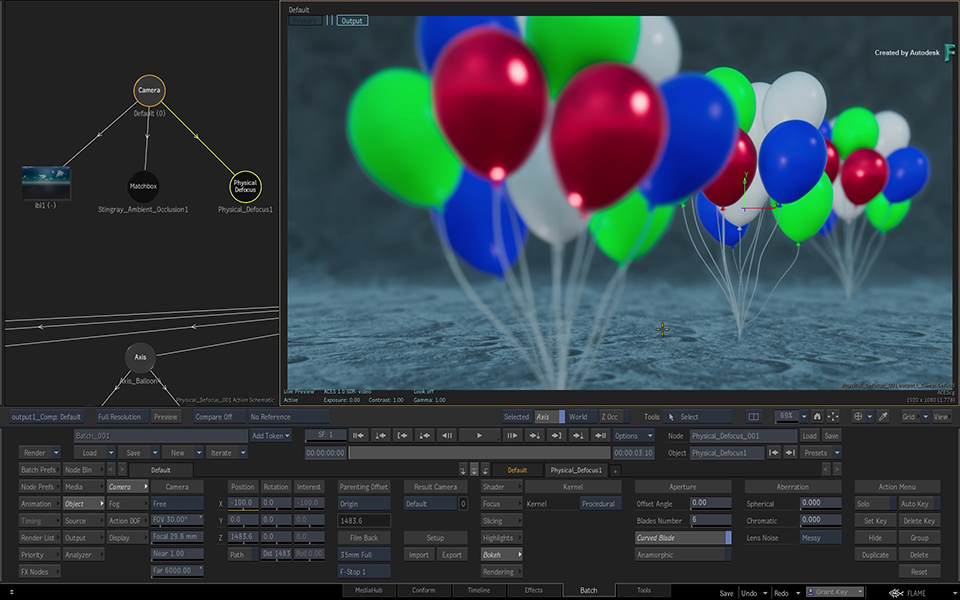 |
Physical Defocus. Use the new PhysicalDefocus matchbox effect for Image, Action and Batch, including customizable Lens Bokeh.
|
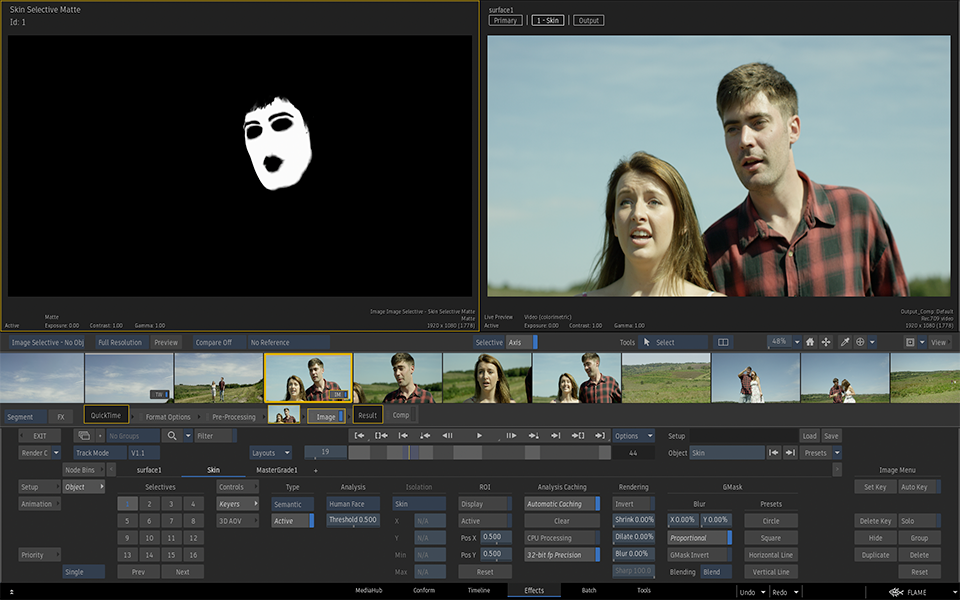 |
ML Human Face Segmentation. Use the new Machine Learning-powered Semantic keyer to isolate common face parts such as mouth and eyes. Also available as a Matchbox, MLHumanFaceExtraction. |
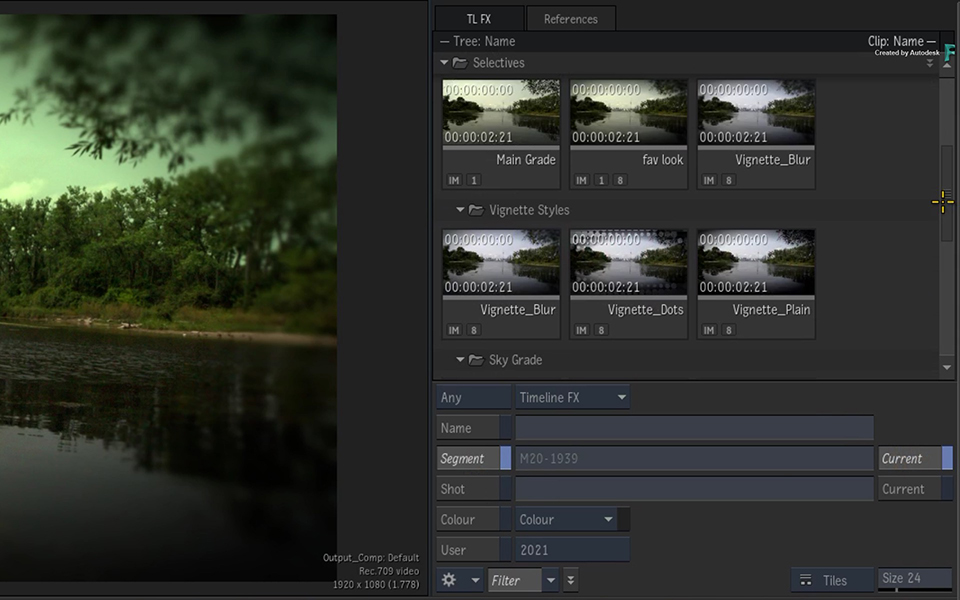 |
Effects enhancements. Use the new Explorer to manage effects and references, view the Storyboard on the broadcast monitor, quickly create shaped GMasks. |
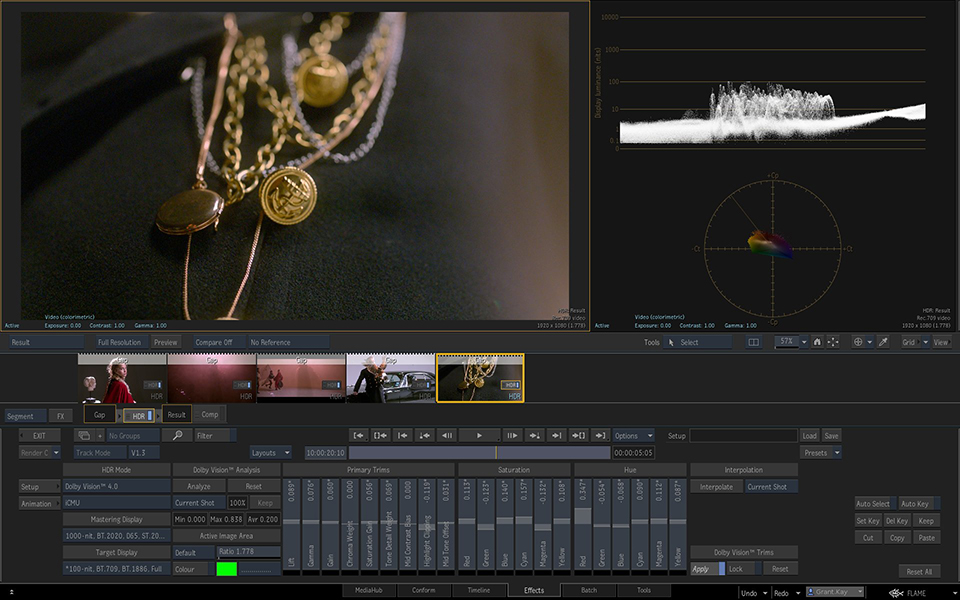 |
Dolby Vision® technology for HDR authoring and display workflow. Use the new HDR track to manage Dolby Vision metadata, perform content analysis using Dolby Vision CMv2.9 and CMv4.0, monitor through iCMU, eCMU, or HDMI tunneling, import and export Dolby Vision XML files for collaborative workflows. Flame Family products version 2021.0.1 have been certified by Dolby Laboratories® as compatible with Dolby Vision™. |
Additional information:
Many new feature videos (as well as other workflow videos) are available on the Flame Learning Channel. This channel is updated frequently, so be sure to subscribe.
Links to 2021 videos are denoted by this icon:

In this What's New topic,
 indicates a new feature or enhancement that was suggested and voted up by Flame Family users on the Feedback portal (also accessible directly from Product menu
indicates a new feature or enhancement that was suggested and voted up by Flame Family users on the Feedback portal (also accessible directly from Product menu  Help).
Help).Make sure to check out Flame Central, the hub for all your Flame Family links.
Looking for the Release Notes for Flame Family 2021? Click here: Flame Family 2021 Release Notes.
Welcome Screen
Want to get only the highlights of the release? Let the Welcome Screen show you to the new features. It opens the first time you launch a Flame Family product.
Or access it anytime from Product menu  Help.
Help.
For details on all the new features and enhancements in this release, follow these links:
- Action/Image
- Action/Image/GMask Tracer
- Archiving
- Backburner
- Batch andBatch FX
- Broadcast Monitoring
- Burn-In Letterbox
- Colour Corrector
- Compare Workflow
- Connected Conform
- Effects Environment
- HDR Using Dolby Vision
- Matchbox
- MediaHub
- Media Export
- Media Import
- Media Panel
- Overlays, Grids, and Guides
- Player
- Preferences
- Projects and Users Management
- Python API
- Python Hooks
- Recursive Ops
- Tangent Panels
- Text
- Timeline
- Timeline FX
- Tools
Action/Image
Selective Node Improvements
 GMask Presets for Selective Nodes
GMask Presets for Selective Nodes
In the Selective Node, you can now access GMask Presets to quickly create a circular, square, or linear GMask automatically parented to the Selective node.
For more information, see Adding a GMask Shape to the Selective.
 Semantic Keyer - Human Face
Semantic Keyer - Human Face
The new Human Face semantic keyer is now available to the Selective node. This new keyer offers you options to segment the human face and then render it using Matchbox shaders applied to the Selective node.
For details on recognized face features, see Semantic Keyer - Human Face.
Improved ML Performances on macOS
Starting with macOS Catalina (version 10.15), machine learning tools now supports GPU rendering. You should see an significant increase in interactivity and rendering performances in every feature relying on machine learning: Selective Semantic Keyer, Normals and Z-Depth texture map procedural generations, and all ML Matchbox shaders.
Action/Image/GMask Tracer
 Set a default value for the Axis Scale parameter in Preferences
Set a default value for the Axis Scale parameter in Preferences  Action
Action  Axis. Any new node is opened with the value defined in the preferences.
Axis. Any new node is opened with the value defined in the preferences.
- The preference is user-based.
- You can always modify the Axis scale in a node from the node's Node Prefs submenu.
 Set the display colours for the GMask object in Preferences
Set the display colours for the GMask object in Preferences  Action
Action  GMask. Any new node is opened with the value defined in the preferences.
GMask. Any new node is opened with the value defined in the preferences.
- The preference is user-based.
- You can always modify the display colours for the GMasks of a node from the node's Node Prefs submenu.
Archiving
Improved space estimation for archives. The space estimation for project archiving now accounts for content on the Desktop that is not used in any sequences.
Skipping TOC conversion. You can now skip the conversion of archives table of contents. This TOC conversion process was introduced in Flame Family version 2020 and automatically converted legacy archive TOC. For more information, see Table of Contents Format Update.
Backburner
 The Backburner server list is now sorted in alphabetical order.
The Backburner server list is now sorted in alphabetical order.
You can now manage Backburner servers located on a different subnet. Use the new Connect To option in Preferences  Backburner
Backburner  Backburner Managers.
Backburner Managers.
Batch and Batch FX
 OpenEXR is now the default selected format in the Write File node.
OpenEXR is now the default selected format in the Write File node.
 Every visible track of a sequence is now available from the View and Reference drop-down menu. The Primary and Secondary tracks are available from the Context. All other tracks are available from the Timeline Tracks menu.
Every visible track of a sequence is now available from the View and Reference drop-down menu. The Primary and Secondary tracks are available from the Context. All other tracks are available from the Timeline Tracks menu.
 The Timebar Once, Loop, Back and Forth mode can now be selected using a keyboard shortcut. The shortcuts are assigned by default in the Flame, Smoke Classic, and Lustre user profiles. They are not assigned in the Smoke (FCP7) profile.
The Timebar Once, Loop, Back and Forth mode can now be selected using a keyboard shortcut. The shortcuts are assigned by default in the Flame, Smoke Classic, and Lustre user profiles. They are not assigned in the Smoke (FCP7) profile.
- Set Play Mode Once: Flame+Enter
- Set Play Mode Loop: Alt+Enter
- Set Play Mode Back and Forth: Space+Enter
 A keyboard shortcut for Clear All Context Views is now available in the Keyboard Shortcut Editor.
A keyboard shortcut for Clear All Context Views is now available in the Keyboard Shortcut Editor.
- Flame and Lustre user profiles: Shift+=
- Smoke Classic and Smoke (FCP7): Ctrl+-
Output Node Media Compression
 You can now define the compression for the following media formats in the Output node. Use the menu next to the Offset numerical field.
You can now define the compression for the following media formats in the Output node. Use the menu next to the Offset numerical field.
- DPX (Uncompressed, Packed, Pixspan)
- Jpeg (Quality)
- OpenEXR (Uncompressed, B44, B44A, DWAA, DWAB, PIZ, PXR24, RLE, Multi_Scanline, and Scanline)
- SGI (Uncompressed, RLE)
- TIFF (Uncompressed, RLE, LZW)
- TX (Uncompressed, RLE)
Broadcast Monitoring
You can now control the broadcast monitor type and preview mode from anywhere using keyboard shortcuts. For more details, see Displaying a Clip in the Broadcast Monitor.
The broadcast monitor now defaults to Viewing Area when Show Selected Item is not available.
 You can now send only the viewing area from the Player or Viewport to the broadcast monitor. This makes it possible for attendees to see pan and zoom modifications on the broadcast monitor.
You can now send only the viewing area from the Player or Viewport to the broadcast monitor. This makes it possible for attendees to see pan and zoom modifications on the broadcast monitor.
Use Scale to Fit Monitor to fit the viewing area output to the broadcast monitor if the graphics and broadcast monitor do not have the same resolution.
 Scale to Fit Monitor is now enabled by default.
Scale to Fit Monitor is now enabled by default.The Toggle Broadcast Monitor Preview Mode keyboard shortcut has been renamed to Cycle Broadcast Monitor Preview Modes. It now cycles between Show Selected Item, Screen Grab and Viewing Area.
Burn-In Letterbox
 New aspect ratio presets are now available to the Burn-in Letterbox:
New aspect ratio presets are now available to the Burn-in Letterbox:
- 0.56:1 (9:16 Vertical)
- 0.67:1 (2:3 Vertical)
- 0.80 (4:5 Vertical)
- 1.00:1 (Square)
- 1.50:1 (3:2 Vertical)
- 1.89:1 (American 35mm)
- 2.00:1 (Red Cameras)
- 2.39:1 (CinemaScope)
- 2.40:1 (CinemaScope)
- 2.70:1 (Ultra 70)
- 4.00:1 (Polyvision)
Colour Corrector
 The maximum values of the RGB Gain settings have been augmented to 10000.
The maximum values of the RGB Gain settings have been augmented to 10000.
Compare Workflow
Flame Family 2020.2 Update introduced a new method to compare clips to reference images. Version 2021 improves on this workflow with the following changes.
 Split in Batch and Effects. The Horizontal and Vertical Split compare modes are now available from Batch and the Effects tab. Keyboard shortcuts are available for the keyboard and Tangent panels but they are not assigned by default.
Split in Batch and Effects. The Horizontal and Vertical Split compare modes are now available from Batch and the Effects tab. Keyboard shortcuts are available for the keyboard and Tangent panels but they are not assigned by default.
 Broadcast the comparison. The reference image is now shown in the broadcast monitor when the Horizontal, Vertical, or Angle Split compare modes are selected from anywhere in the application.
Broadcast the comparison. The reference image is now shown in the broadcast monitor when the Horizontal, Vertical, or Angle Split compare modes are selected from anywhere in the application.
 Resize in Angle Split. Move, scale, and resize references independently from the image displayed in the viewport when in Angle Split.
Resize in Angle Split. Move, scale, and resize references independently from the image displayed in the viewport when in Angle Split.
 Improved Difference mode in Player and Viewports.
Improved Difference mode in Player and Viewports.
- The maximum values of the Lift and Gain field have been augmented.
- The default value of the Minimum setting is now 0.0.
- Switch between RGB and YUV modes using a button, a keyboard shortcut and on the Tangent Panel. The keyboard shortcut and Tangent panel option are not assigned by default.
 Grab from the Player. You can now use the keyboard shortcuts Compare: Grab Reference and Compare: Grab Reference and Rename from the Player to add a new reference to the Grabbed References library.
Grab from the Player. You can now use the keyboard shortcuts Compare: Grab Reference and Compare: Grab Reference and Rename from the Player to add a new reference to the Grabbed References library.
 Default name. You can now create a default name automatically assigned to grabbed references. The default name is defined in Preferences
Default name. You can now create a default name automatically assigned to grabbed references. The default name is defined in Preferences  Tools / TL FX
Tools / TL FX  Default Reference Name. You can use the
Default Reference Name. You can use the default_reference_name python hook available in /opt/Autodesk/<version>/python/hook.py to force a naming convention across multiple projects and users.
Drag and Drop Compare. You can now drop a Reference from the Media Panel or the new Explorer panel onto a viewport in the Effect and Batch environments. This automatically enables Compare.
Bake the View Transform. With the Bake View Transform button now available in the Add Reference dialog box, you can now bake current Viewing Transform in the grabbed reference. When enabled, the viewing transform is baked and the colour space tag can be set to the Graphics Colour Space or Broadcast Colour Space. If you do not bake the view transform the colour space tab remains the same.
The keyboard shortcuts used to cycle the grabbed references have been modified.
- Compare: Select Previous Grabbed Reference: Ctrl+Print Screen (CentOS) / Ctrl+F13 (macOS)
- Compare: Select Next Grabbed Reference: Ctrl+Scroll Lock (CentOS) / Ctrl+F14 (macOS)
- Compare: Display Current Grabbed Reference: Shift+Pause (CentOS) / Shift+F15 (macOS)
- Compare: Display Previous Grabbed Reference: Shift+Print Screen (CentOS) / Shift+F13 (macOS)
- Compare: Display Next Grabbed Reference: Shift+Scroll Lock (CentOS) / Shift+F14 (macOS)
Additional improvements
 New tokens are available for the Default Reference Name preference and in the Add Reference dialog window.
New tokens are available for the Default Reference Name preference and in the Add Reference dialog window.- You can now reset the reference's position and scale attributes with Reset Reference Settings in the Reference drop-down list or the Reset Reference Settings keyboard shortcut (not assigned).
- The pivot position and angle for the Angle, Horizontal, and Vertical splits are now unique to each viewport.
- The reference selection is now viewport-based.
Connected Conform
 Duplicated connected segments can now be added above or below the selected segment by using the Direction setting in the Duplicate Connected Segment dialog box.
Duplicated connected segments can now be added above or below the selected segment by using the Direction setting in the Duplicate Connected Segment dialog box.
Effects Environment
Colour code segments. You can now set the colour coding of a timeline segment from the Effects environment using the Storyboard's context menu.
Go back to that frame. Use Preferences  Tools / TL FX
Tools / TL FX  Effects Timebar
Effects Timebar  Remember Last Frame to go back to the frame set as the Thumbnail, or to the last visited frame on a clip when you navigate between clips in the Storyboard. With Remember Last Frame, the positioner automatically goes to the first frame.
Remember Last Frame to go back to the frame set as the Thumbnail, or to the last visited frame on a clip when you navigate between clips in the Storyboard. With Remember Last Frame, the positioner automatically goes to the first frame.
Always display the Colour Sampler. The Colour Sampler now stays open when you select a different clip in the Storyboard.
Menu context without selection. Options, including colour coding, selected from the context menu are applied to the segment under the cursor in the Storyboard, even if the segment is not selected.
 Storyboard view on Broadcast. A viewport set to the Storyboard view can now be sent to the Broadcast Monitor when Show Selected Item is selected. This is also true for the Broadcast Toolbar.
Storyboard view on Broadcast. A viewport set to the Storyboard view can now be sent to the Broadcast Monitor when Show Selected Item is selected. This is also true for the Broadcast Toolbar.
 Tracks in View and Reference. Every visible track of sequence is now available in the View and the Reference menus. The Primary and Secondary tracks are available in the Context submenu. Other tracks are available from the Timeline Tracks submenu, also from the Context submenu.
Tracks in View and Reference. Every visible track of sequence is now available in the View and the Reference menus. The Primary and Secondary tracks are available in the Context submenu. Other tracks are available from the Timeline Tracks submenu, also from the Context submenu.
Update numerics on drag. Use Preferences  Tools / TL FX
Tools / TL FX  Effects Timebar
Effects Timebar  Update Numerics to determine if the values of numeric fields update while you drag in the timebar.
Update Numerics to determine if the values of numeric fields update while you drag in the timebar.
Faster navigation for all. Navigating between clips in Effects should now be as fast on macOS as it is on CentOS.
The Explorer
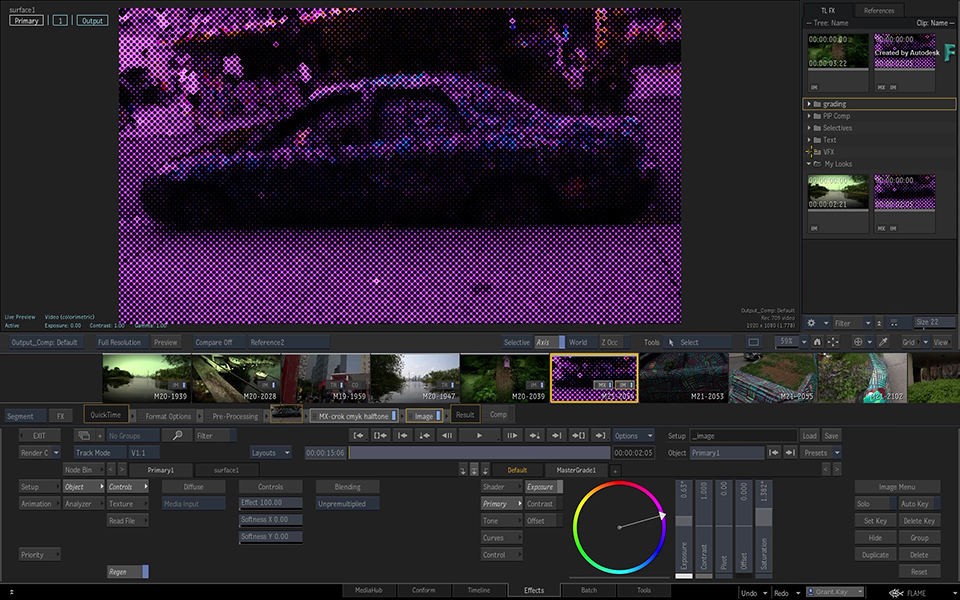 |  | 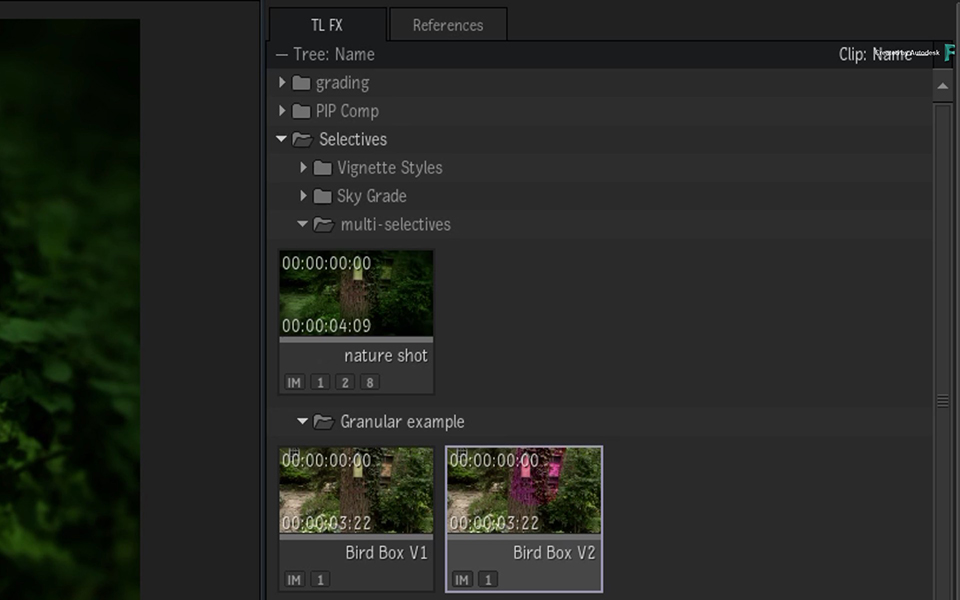 |
 Introduction to working with grading and Timeline FX Presets in the Explorer Introduction to working with grading and Timeline FX Presets in the Explorer |  Organizing and filtering grading and Timeline FX resets in the Explorer Organizing and filtering grading and Timeline FX resets in the Explorer |  Working with Selectives and the Explorer Working with Selectives and the Explorer |
The Explorer is a new tool aimed a facilitating your work on the Storyboard. Replacing the Media Panel in the Effects environment, the Explorer allows you to quickly store and retrieve Timeline FX setups and references.
For more information, see About the Explorer.
High Dynamic Range Content Using Dolby Vision®
Flame Family products version 2021 support the Dolby Vision technology from Dolby Laboratories.
Flame Family products version 2021.0.1 have been certified by Dolby Laboratories as compatible with Dolby Vision.
Dolby Vision technology offers scene-to-scene active metadata, producing an enhanced viewing experience for high dynamic range content. Many popular content providers like Apple, Netflix, and Amazon support Dolby Vision technology.
By using Dolby Vision technology from Dolby, Flame Family products can output HDR content along with metadata for properly tone mapping to Standard Dynamic Range (SDR) or a range of High Dynamic Range (HDR) displays. This allows you to target both SDR and HDR displays from a single master deliverable.
For more information, see Create HDR Content using Dolby Vision.
Matchbox
macOS Improved ML Performances
On macOS 10.15 and up, machine learning now supports GPU rendering. You should see an significant increase in interactivity and rendering performances in every feature relying on machine learning: Selective Semantic Keyer, Normals, Z-Depth texture map procedural generation and all ML Matchbox shaders.
Physical Defocus
 | 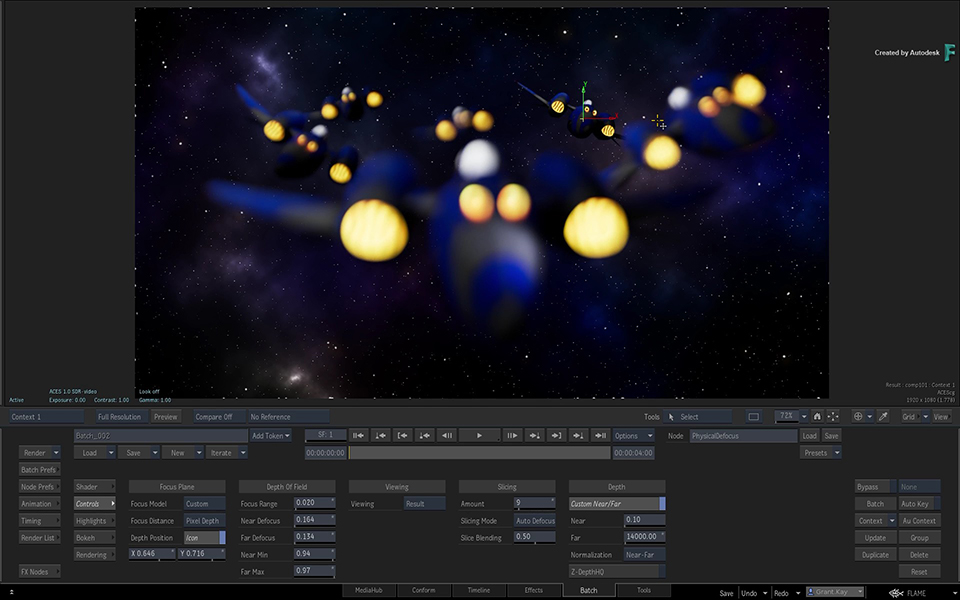 | 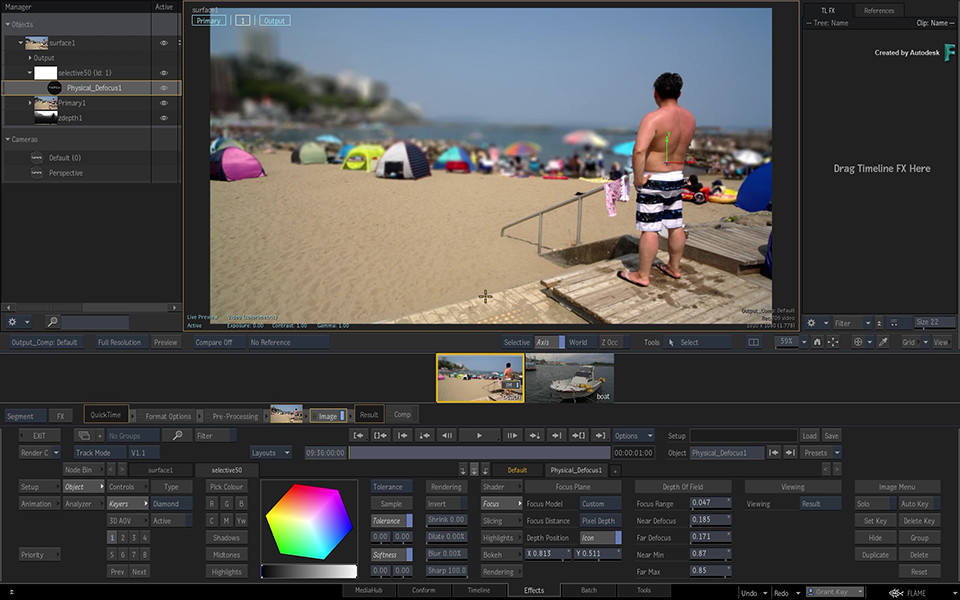 |
 Depth of Field with Physical Defocus: 3D Composite Depth of Field with Physical Defocus: 3D Composite |  Depth of Field with Physical Defocus: CGI Render Passes Depth of Field with Physical Defocus: CGI Render Passes |  Depth of Field with Physical Defocus: Live Action & Machine Learning Depth of Field with Physical Defocus: Live Action & Machine Learning |
A new Matchbox shader called PhysicalDefocus is now available. This new tool completes the previously released Physical Bokeh and Convolve by adding depth support to the same convolution engine. The node offers two independent Defocus model: Custom and Physical. The node also offers different ways to set the focus plane, as well as leverages the Action Camera. It uses the same Procedural Kernel as the one found in Physical Bokeh, but you can provide your own.
For more information, see PhysicalDefocus Matchbox
PhysicalLensKernel
The new PhysicalLensKernel provides real camera bokeh elements to be fed in the Kernel input of the Physical Defocus Matchbox node.
Infill Blur
Use the new Infill Blur Matchbox to fill a the region defined by the Selective with the colour surround that region. Use it for tasks where you have to replace a section of an image with uniform colour.
For more information, see Infill Blur Matchbox.
Depth Normalizer
Use the new Depth Normalizer to convert absolute depth maps into normalized depth maps, where values are between 0.0 and 1.0. Action nodes that require a depth map expect a normalized map. Use this Matchbox to provide such a map.
For more information, see Depth Normalizer Matchbox.
MLHumanFaceExtraction
MLHumanFaceExtraction outputs matte coverage automatically based on a preset selection.
For more information, see MLHumanFaceExtraction Matchbox.
MLHumanFaceTemplates
MLHumanFaceTemplates allows you to see the UV Unwrap coverage of the Action Selective Human Face Semantic Keyer and the MLHumanFaceExtraction shader. You can edit this UV map to create custom coverage.
For more information, see MLHumanFaceTemplates Matchbox.
MediaHub
 The folder that was previously selected as the current folder is now framed in the Folders list when you navigate up a level using the Up button or the bread-crumbs path.
The folder that was previously selected as the current folder is now framed in the Folders list when you navigate up a level using the Up button or the bread-crumbs path.
Keyboard Shortcuts can now be used to navigate the Folders and Files sections of both the MediaHub and the file browser. The shortcuts below are defined in every Keyboard Shortcuts Profile, except for Scroll Up (Folders structure) and Scroll Down (Folders structure): they are not defined in the Smoke FCP7 profile.
| Scroll Page Up | Shift+Space+Up Arrow |
| Scroll Page Down | Shift+Space+Down Arrow |
| Scroll Up (Folders structure) | Space+Page Up |
| Scroll Down (Folders structure) | Space+Page Down |
| Scroll Page Up (Folders structure) | Shift+ Space+Page Up |
| Scroll Page Down (Folders structure) | Shift+Space+Page Down |
Media Export
New H.264 Export Presets for Blu-ray
NTSC/Pal, 720p, 1080i, and 1080p (8 Mbits and 20 Mbits) export presets are now available in the H.264 section of the Movie presets.
Sony Updates
New XAVC LongGOP (MXF) options are now available in the Movie export mode:
- Sony XAVC Long HD (1280x720 / 1920x1080 10-bit 4:2:2
- Sony XAVC Long 4K (3840x2160 8-bit 4:2:0)
- Sony XAVC Long 4K 422 (3840x2160 10-bit 4:2:2)
Export presets using the above options are now available. For SGamut colour spaces, Sony recommends using Export Window  Movie Options
Movie Options  YUV Encoding
YUV Encoding  Full Range.
Full Range.
Sony XDCAM 422 GOP Status. You can now set the status of Group Of Pictures (GOP) when encoding content as Sony XDCAM 422 (MXF). The default (suggested by Sony) is Open GOP. But if your broadcaster delivery specifications require Close GOP, use Export Window  Movie Options
Movie Options  Profile
Profile  Close GOPs. This is only available to the MXF Movie Format using the XDCAM 422 compression.
Close GOPs. This is only available to the MXF Movie Format using the XDCAM 422 compression.
AVID DNxHD
Avid changed how they name the Avid DNxHD compressions in Avid Media Composer 2019.12.
Ever since the introduction of DNx compression, Avid has based the compression names on their data rate per second. With the introduction of Media Composer 2019.12, Avid changes the name of the DNxHD compressions to instead reflect the quality of the encoding.
| Old Name | New Name |
|---|---|
| DNxHD 36 | DNxHD LB |
| DNxHD 80 | DNxHD TR |
| DNxHD 115 | DNxHD SQ |
| DNxHD 175 | DNxHD HQ |
| DNxHD 175x | DNxHD HQX |
| DNxHD 350x | DNxHD 444 |
To reflect this change, the name of the various compressions and the Export presets have been updated to match.
Additional Improvements
Unresolved tokens. When a token cannot be resolved at export, a red box outlines it in the Pattern field. An error message also appears in the File Name field.
Video I/O. The Real-Time Deliverable feature is now deprecated and no longer available.
Renamed Backberry. The Blackberry Playbook name has been replaced by Baseline, the following presets H.264 export presets renamed:
- Baseline (1080p 4Mbits). Was Blackberry Playbook (1080p 4Mbits)
- Baseline (1080p 12Mbits). Was Blackberry Playbook (1080p 12Mbits)
- Baseline (1080p 20Mbits). Was Blackberry Playbook (1080p 20Mbits)
Media Import
Sony Updates
Sony VENICE firmware 5.0 is now supported, with new High Frame Rates and Apple ProRes support:
New HFR formats:
- 6K 1.85:1: 31 to 60, 66, 72 fps
- 6K 17:9: 31 to 60, 66, 72 fps
- 6K 2.39:1: 31 to 60, 66, 72, 75, 90 fps
- 4K 2.39:1: 1 to 60, 66, 72, 75, 90, 96, 100, 110, 120 fps
Apple ProRes:
- 4444 (1920x1080, 23,98 to 30 fps)
There is also improved support for Sony XAVC Long-GOP content in MXF wrapper, including Colour Space metadata.
Canon Updates
Canon C500 Mark II. XF-AVC MXF files from the Canon C500 Mark II are now supported. These files are AVC-Intra with Long-GOP.
The Canon C500 Mark II records in XF-AVC and CRM formats.
Resolutions and frames per second:
- Full Frame (17.9) 5.9K up to 60fps
- 4K DCI / UHDTV up to 60fps
- 2K DCI / HDTV up to 120p
Colour Spaces:
- BT.709
- BT.2020
- Canon Log 2
- Canon Log 3
- PQ
- HLG
Canon XF705. MXF files from the Canon XF705 camera are now supported. You can import the XF-AVC (45Mpbs) 1920x1080 (23.98 to 60fps) directly. The XF-HEVC files require MediaReactor for decoding.
RED Updates
Files from the RED Komodo are now supported.
Pixspan Updates
Support Pixspan 3.4.24. This update removes thumbnail generation on export for improved encoding performance.
Support for EXIF Information
The information contained in the Exchangeable Image File Format (Exif) metadata is now displayed in MediaHub  Preview
Preview  Metadata, for the following formats:
Metadata, for the following formats:
- JPEG
- PSD
- TIFF
When you browse a JPEG file sequence, the Exif orientation metadata is now read to ensure the files are viewed using the correct orientation.
Media Panel
You can now use keyboard shortcuts to scroll the Media Panel page-by-page.
- Scroll Page Up: Shift+Space+Up Arrow
- Scroll Page Down: Shift+Space+Down Arrow
Tab switch. You can now switch between tabs in the Media panel by holding a clip over a tab.
With the introduction of the Explorer, we had to change how you control the display of the Media Panel.
Hide or show the Media Panel with Flame menu
 Show/Hide Media Panel.
Show/Hide Media Panel.Keyboard shortcuts available in previous versions are still available.
Use the Media Panel's Gear menu to set the Full Width and Full Height options.
To clear the content of the Media Panel, you can still use the context menu or use the new keyboard shortcut Ctrl+Shift+NUMPAD*.
Overlays, Grids, and Guides
 New aspect ratio presets are now available to Overlays, Grids, and Guides :
New aspect ratio presets are now available to Overlays, Grids, and Guides :
- 0.56:1 (9:16 Vertical
- 0.67:1 (2:3 Vertical)
- 0.80 (4:5 Vertical)
- 1.00:1 (Square)
- 1.50:1 (3:2 Vertical)
- 1.89:1 (American 35mm)
- 2.00:1 (Red Cameras)
- 2.39:1 (CinemaScope)
- 2.40:1 (CinemaScope)
- 2.70:1 (Ultra 70)
- 4.00:1 (Polyvision)
 All Overlay presets selections are now persisted between sessions. This includes the OFF option.
All Overlay presets selections are now persisted between sessions. This includes the OFF option.
Player
 You can now use keyboard shortcuts to select the different Player playback modes: Once, Loop, Back and Forth. The following keyboard shortcuts are already assigned in every keyboard shortcuts profile, except for the Smoke (FCP 7) one.
You can now use keyboard shortcuts to select the different Player playback modes: Once, Loop, Back and Forth. The following keyboard shortcuts are already assigned in every keyboard shortcuts profile, except for the Smoke (FCP 7) one.
- Set Play Mode Once: Meta+Enter
- Set Play Mode Loop: Alt+Enter
- Set Play Mode Back and Forth: Space+Enter
Preferences
 You can now set the preferred date and time formats Preferences
You can now set the preferred date and time formats Preferences  User Interface
User Interface  Date/Time Display.
Date/Time Display.
- Use Display Seconds to show or hide the seconds.
- The selected date and time format is used by the different list views as well as by the <date> and <time> tokens.
 Force the list views to use the longer version of the date format with Preferences
Force the list views to use the longer version of the date format with Preferences  User Interface
User Interface  Date/Time Display
Date/Time Display  Always Use Long Format button.
Always Use Long Format button.
 You can now remove underscores from the information returned by the <date> and <time> tokens. Enable the option Preferences
You can now remove underscores from the information returned by the <date> and <time> tokens. Enable the option Preferences  User Interface
User Interface  Date/Time Display
Date/Time Display  Compact Tokens Result. For example,
Compact Tokens Result. For example, <date>_<time> returns:
- YYYY_MM_DD_HH_MM with Compact Tokens Result disabled (default).
- YYYYMMDD_HHMM with Compact Tokens Result disabled enabled.
 Audio monitoring (formerly known as Enable Audio) is controlled by Preferences
Audio monitoring (formerly known as Enable Audio) is controlled by Preferences  Audio
Audio  Audio Monitoring. You can now be toggle audio monitoring from anywhere in the software using:
Audio Monitoring. You can now be toggle audio monitoring from anywhere in the software using:
- The Toggle Audio Monitoring keyboard shortcut: Meta+Alt+A in every keyboard shortcuts profile.
- The Toggle Audio Monitoring option on the Tangent Panel. For more information, see Tangent Panels.
Projects and Users Management
You can now create new projects and users from within the application. You no longer have to do this from the Start screen.
You can now create a new workspace from the Project and User settings window by using the Workspace drop-down menu. Once created, load the current project to access the new workspace.
Python API
The Python API is augmented with additional attributes and properties in Action, Batch, and Project management.
For more information, see Python API documentation
Python Hooks
A Python script example on how to encode a QuickTime from a Write File node is available in /opt/Autodesk/
Recursive Ops
 The defaults for the Recursive Ops tool have been modified: everything is disabled by default, with Blending mode set to Max.
The defaults for the Recursive Ops tool have been modified: everything is disabled by default, with Blending mode set to Max.
Tangent Panels
The following are new functions available to the Tangent panels.
Updates to Selective controls
- Shape Presets (Circle, Square, Horizontal and Vertical line)
- On the Tangent Arc and Element panels, the default shapes functions now the selective presets. The legacy manual shape function have been mapped on the Alternate mode (ALT).
- Arc
- Function module
- Square (ALT = Rectangle)
- Circle (ALT = Ellipse)
- V Line (ALT = Plane)
- H Line (ALT = Free)
- Function module
- Element
- BT-1
- Square (ALT = Rectangle)
- Circle (ALT = Ellipse)
- V Line (ALT = Plane)
- H Line (ALT = Free)
- BT-1
- Arc
Updates to Navigation controls
- Clip List, MediaHub & Schematic View Navigation: On the Tangent Arc panel, it is now possible to navigate within the MediaHub, Media Library, Timeline and Batch FX Schematic View.
- Function module:
- MediaHub (other mode):
- Page Up/Down: nagivate Clip List pages
- Up/Down: nagivate Clip List 1 line up/down
- Left/Right: nagivate Clip List left right
- MediaHub (other mode) (ALT mode):
- Page Up/Down: navigate folder list pages
- Up/Down: navigate folder list 1 line up/down
- Left/Right: n/a
- Batch FX Schematic View (other mode):
- Page Up/Down: n/a
- Up/Down: navigate Schematic view Up/Down
- Left/Right: navigate Schematic view Left/Right
- Media Panel mode:
- Page Up/Down: nagivate Media Panel pages
- Up/Down: nagivate Media Panel 1 line up/down
- Left/Right: nagivate Media Panel left right
- Timeline mode:
- Page UpDown: n/a
- Up/Down: navigate Timeline view Up/Down
- Left/Right: navigate Timeline view Left/Right
- TL Home: set Timeline view to Home view
- MediaHub (other mode):
Updates Video and Audio Monitoring controls
- On the Tangent Arc panel (Navigation module), it is now possible to select the Video Device and the Preview Mode (All mode, left button bank, ALT mode)
- V Device: press to toggle between your laste selected device (SDI, DVI or HDMI) and off mode.
- PView Mode: press to cycle between Show Selected Item, Viewing Area and Screen Grab.
Additional Updates
- Play Modes (Tangent Arc: Navigation module in all modes):
- Play Backward button (ALT mode = Play Once)
- Stop button (ALT mode = Play Loop)
- Play Forward button (ALT mode = Play BkFt)
- Top Visible Track Navigation:
- Tangent Arc (Navigation module) (All modes): Up button (ALT mode = Focus Top Track)
- Tangent Element (MF module): Up button (ALT mode = Focus Top Track)
- Video and Audio Monitoring (Tangent Arc: Navigation module in all modes):
- MONITORING section (left button bank ALT mode):
- Video
- Audio
- MONITORING section (left button bank ALT mode):
Saving Timeline FX and Selective From a Tangent Panel
On the Tangent Arc and Element panels, use the new EXPLORER page to save Timeline FXs and Image Selectives.
Tangent Arc
On the Navigation module, user can navigate to the Explorer page for FX and Selective saving action:
Press Keypad to toggle the Keypad modes
EXPLORER page
Save FX: Save Timeline FX(s) to Explorer's Top Level (Skip Rename)
ALT mode: Save FX: Save Timeline FX(s) to Explorer's Top Level
Save FX>: Save Timeline FX(s) to Explorer's Selected Item (Skip Rename)
ALT mode: Save FX >: Save Timeline FX(s) to Explorer's Selected Item
For Image FX Selective modes, the following actions are also available:
Save Sel: Save Selective(s) to Explorer's Top Level (Skip Rename)
ALT mode : Save Sel*: Save Selective(s) to Explorer's Top Level
Save Sel >: Save Selective(s) to Explorer's Selected Item (Skip Rename)
ALT mode : Save Sel >: Save Selective(s) to Explorer's Selected Item
Filter: enable/disable Explorer panel filtering
Tangent Element
On the MF module, navigate to the Explorer page for FX and Selective saving action:
Press A to toggle the Buttons modes.
On the EXPLORER page:
Save FX: Save Timeline FX(s) to Explorer's Top Level (Skip Rename)
ALT mode: Save FX*: Save Timeline FX(s) to Explorer's Top Level
Save FX>: Save Timeline FX(s) to Explorer's Selected Item (Skip Rename)
ALT mode: Save FX >: Save Timeline FX(s) to Explorer's Selected Item
For Image FX Selective modes, the following actions are also available:
Save Sel: Save Selective(s) to Explorer's Top Level (Skip Rename)
ALT mode : Save Sel*: Save Selective(s) to Explorer's Top Level
Save Sel >: Save Selective(s) to Explorer's Selected Item (Skip Rename)
ALT mode : Save Sel >: Save Selective(s) to Explorer's Selected Item
Filter: enable/disable Explorer panel filtering
Tangent Mapper
Using the updated Tangent Mapper product, you can customise the panels' mapping with the following actions:
Explorer:
- Toggle the Explorer's Filter
Selective and Object Views (for the Action group)
- Object View
- Dynamic Object View
- Dynamic Object View Type
- Dynamic Selected View
Timeline FX:
- Save Timeline FX to Explorer's Top Level
- Save Timeline FX to Explorer's Selected Item
- Save Timeline FX to Explorer's Top Level (Skip Rename)
- Save Timeline FX to Explorer's Selected Item (Skip Rename)
Action (for Image Timeline FX):
- Save Selective to Explorer's Top Level
- Save Selective to Explorer's Selected Item
- Save Selective to Explorer's Top Level (Skip Rename)
- Save Selective to Explorer's Selected Item (Skip Rename)
Text
Better support for fonts. You ca now load .pfb and .ttc fonts where fonts can be loaded. And if the font browser filter is set to Auto, only a single instance of each font is displayed.
Timeline
The rendering time of Batch FXs and Timeline FXs has been improved.
- Batch FX: Rendering in Batch FX should now be as fast as rendering the same setup in Batch.
- Timeline FX: For segments that have rendered frames in their middle, rendering the remaining frames is now faster.
The thumbnail of the current clip is no longer displayed within the Media Panel inside Batch FX. It is replaced by an Opened BFX slate.
Additional Keyboard Shortcuts
 The current opened Sequence can now be closed using a keyboard shortcut.
The current opened Sequence can now be closed using a keyboard shortcut.
- Flame and Lustre user profiles:
- Close Sequence: Meta+C
- Close All Sequences: Meta+Alt+C
- Smoke Classic and Smoke (FCP7) user profiles:
- Close Sequence: Ctrl+W
- Close All Sequences: Ctrl+Smoke+W
 The Positioner's vertical focus can be moved to the topmost visible track of the current version using:
The Positioner's vertical focus can be moved to the topmost visible track of the current version using:
- Set Focus on Top Visible Track keyboard shortcut.
- Flame and Lustre user profiles: Shift+Page Up
- Smoke Classic and Smoke (FCP7) user profiles: Ctrl+Alt+Up Arrow
- Focus Top Visible Track option on the Tangent panel
Improvements have been made to the Timeline's Uncontain function:
 All selected containers can be uncontained at once.
All selected containers can be uncontained at once. A keyboard shortcut is now available:
A keyboard shortcut is now available:- Flame, Lustre, and Smoke Classic : Meta+`
- Smoke (FCP7): Alt+Shift+C
 The Flush Renders keyboard shortcut that previously only applied to the selected clips of the Media Panel can now be used on the selected segments in the Timeline. It is not assigned to default keyboard shortcut.
The Flush Renders keyboard shortcut that previously only applied to the selected clips of the Media Panel can now be used on the selected segments in the Timeline. It is not assigned to default keyboard shortcut.
 A keyboard shortcut for the Consolidate Handles option from the context menu for clips and timeline segments is now available in the Keyboard Shortcut Editor. It is assigned to Meta+Shift+C in every keyboard shortcuts profile.
A keyboard shortcut for the Consolidate Handles option from the context menu for clips and timeline segments is now available in the Keyboard Shortcut Editor. It is assigned to Meta+Shift+C in every keyboard shortcuts profile.
 The Zoom In and Zoom Out keyboard shortcut do now repeat when you hold them down while the focus is on the Timeline.
The Zoom In and Zoom Out keyboard shortcut do now repeat when you hold them down while the focus is on the Timeline.
Timeline FX
 The Centre controls of the Action and 2D Transform Timeline FX are now available from the Timeline FX Ribbon.
The Centre controls of the Action and 2D Transform Timeline FX are now available from the Timeline FX Ribbon.
 You automatically switch to the Effects environment when you use an Add x Effect keyboard shortcut on a segment that already has that Timeline FX.
You automatically switch to the Effects environment when you use an Add x Effect keyboard shortcut on a segment that already has that Timeline FX.
Tools
 All tools now have the possibility to update the image in the viewport while a numeric field is being modified.
All tools now have the possibility to update the image in the viewport while a numeric field is being modified.
The following tools do not have any option available. The image always updates:
- 2D Histogram
- Auto Matte
- Colour Curves
- Difference Matte
- Field Merge
- Filter
- Keyer Luma
- Matte Curves
- Posterize
- Regrain
The following tools now have a Regen button:
- Average
- Compound
- Degrain
